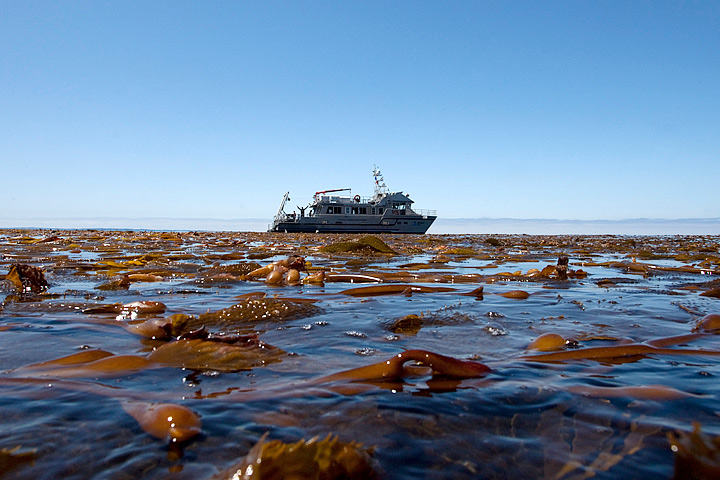

Giant kelp are fast growers, and they thrive in cold, nutrient-dense waters, particularly where there is a rocky and shallow seafloor (5 to 30 meters or 15 to 100 feet). They attach to the seafloor with small root-like structures (haptera) also called, appropriately enough, a holdfast. The holdfast supports a stipe, or stalk, and leaf-like blades that float thanks to air-filled pockets (pneumatocysts). The fronds create dense floating canopies on the water surface, yet these massive plants rely on holdfasts barely 60 centimeters (24 inches) wide to keep them rooted and alive.
Given the right balance of conditions, giant kelp can grow as much as 50 centimeters (1.6 feet) per day, and this robust growth makes it possible for kelp fronds to be commercially harvested. Giant kelp have been plucked from California waters since the early 1900s, and they have long appeared in products like ice cream and toothpaste. At the industry’s peak, large ships using lawnmower-like machinery could harvest more than 200,000 wet tons annually.

Kelp fronds create dense floating canopies near the water surface. Kelp have been harvested for a century for commercial products; they also pose trouble for boat propellers. (Photo courtesy of Chad King / NOAA MBNMS)
“The satellite could definitely see the effects of harvesting, but the kelp recovery was very fast,” said Tom Bell, a UCSB researcher and collaborator with Byrnes and Cavanaugh.
Today, only a few thousand tons of giant kelp are harvested each year, some by hand and some by mechanical harvesters. The kelp can be trimmed no lower than 4 feet below the water surface, and this sustainable harvesting is the equivalent of humans getting a haircut. Studies have shown that negative affects are negligible, although some fish populations are temporarily displaced.

Giant kelp thrive in cold, nutrient-dense waters, particularly where there is a rocky, shallow seafloor. The California coast provides ideal habitat. (NASA Earth Observatory image by Mike Taylor, using Landsat data from the U.S. Geological Survey)
For years, scientists debated whether it was nutrient availability or grazers (not human harvesters, but sea urchins) that had the most influence over kelp forest health, size, and longevity. After using Landsat to look at long-term trends, and comparing those trends to known differences between Central and Southern California waters, Cavanaugh and LTER lead Daniel Reed found that a third force—wave disturbance—was the kingmaker of kelp dynamics. Strong waves generated by storms uproot the kelp from their holdfasts and can devastate the forests far more than any grazer.